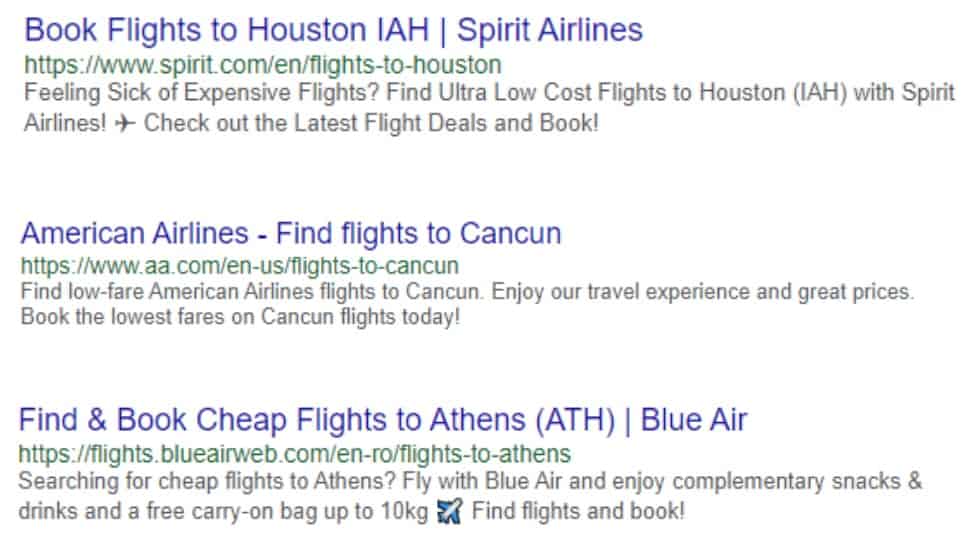This document offers best practices to create meta descriptions for airTRFX pages.
Back to SEO Resources for Airlines >
Who should read this document?
- Staff responsible for SEO
- Staff responsible for the airline’s website
- Staff responsible for making edits on airTRFX Control
Overview
What is a meta description?
The meta description is a meta tag that plays an important role in a page’s search engine optimization (SEO) strategy. Although Google has stated that the meta description is not a ranking factor, a well-written meta description can impact a page’s click-through-rate (CTR), and therefore, improve its ability to rank in organic search.
Where does the meta description appear?
The meta description appears as an HTML tag that provides a description of what the page is about. It is placed in the <head> section of every airTRFX page as seen below.
<meta name=”description” content=”Find low-fare American Airlines flights to Chicago. Enjoy our travel experience and great prices. Get the lowest fares on Chicago flights today!”>
While the HTML tag is not visible on page, it is commonly used by search engines when displaying search results.
Meta Descriptions on airTRFX Pages
How do I know which keywords to use?
airTRFX pages are structured based on templates that target different “keyword permutations”, which are templated search queries that represent the most common search patterns users type when searching for flights.
For example, when searching for flights to a destination, users tend to use “cheap flights to [destination]” rather than “plane offers to [destination]”. Thus, airTRFX groups these different keyword permutations into the following page templates:
- Destinations (or Homepage)
- Flights from City to City
- Flights to City
- Flights from City
- Flights from City to Country
- Flights to Country
- Flights from Country
How can you write unique meta descriptions for all page templates?
Writing meta descriptions for every single landing page would be daunting. That’s why airTRFX uses variables in each page template to enable unique meta descriptions from a single entry, per template. You only need 7 meta descriptions per language!
Can I use any variable on any template?
While all possible variables are listed in dropdowns in each page template, some variables are limited to specific templates. To illustrate, below is an example of a Flights to City meta description, and how it will populate:
- Find low-fare #%#Airline.Name#%# flights to #%#Destination.City#%# (#%#Destination.City.AirportCode#%#). Enjoy our travel experience and great prices. Book the lowest fares on #%#Destination.City#%# flights today!
- Find low-fare American Airlines flights to Mexico City (MEX). Enjoy our travel experience and great prices. Book the lowest fares on Mexico City flights today!
Here is a closer look at the variables used above, and what they correspond to:
Best Practices for Meta Descriptions in airTRFX
Include the target keyword permutation. This will help search engines understand what the page is about. Besides, search engines often bold the user’s search query if it is included within the meta description, which may improve CTR.
Add the airline’s key unique value propositions (UVP). Is the airline known for cheap prices, a generous baggage policy, or great in-flight entertainment? Include your best selling points!
Include a call to action (CTA). Make the meta description more enticing by adding a clear call to action encouraging people to click. Some examples of good CTAs are “Book your flight to [destination] today”, “Find flight offers to [destination]”, “Enjoy your flight to [destination] in premium cabins with free wifi!”.
Avoid keyword stuffing. Including the target keyword once or twice is more than enough. There is no need to use the same words or phrases multiple times. It does not help!
Keep your brand’s tone of voice. Be consistent with the airline’s brand and values.
Keep it within 70-155 characters. If you don’t want search engines to cut off the meta description in search results, stick to 150-155 Latin-alphabet characters. Calculate the longest possible value for each variable. Take it as the baseline and make the appropriate changes to keep the meta descriptions under 155 characters. Keep in mind that having a long meta description for a few pages won’t negatively affect the SEO performance.
Gather ideas from top organic online travel agencies (OTAs) and competitors. Use a sample of target keyword permutations and look at the meta descriptions displayed in the search results. What keywords are others targeting? What CTAs are they using? What benefits are they highlighting? These are key questions that can help you write your own effective meta description!
Avoid boilerplate content that is not applicable to all flights or destinations. Don’t use UVPs that may not be universally true for all flights or destinations. For example, unless all of your airline’s destinations are sunny, don’t add “Find the lowest-priced flight for your sunny vacation in [destination]”.
Don’t forget the meta description field for your custom pages. Remember to use these tips to write meta descriptions for each custom page you create in airTRFX. These are not automatically populated by the meta descriptions on other page templates or require variables.
Google may still rewrite your meta description. If the meta description does not show up in search results for the target keyword permutation, it may be a sign that the meta description is not relevant enough. There is no guarantee that Google will show your meta description on the search results. In fact, Google can show different search results snippets of the same page for different search queries.
However, if Google is not displaying your meta description, it may not necessarily be a problem on your side. Sometimes, Google rewrites meta descriptions in SERP for unclear reasons. Just make sure to write a relevant meta description for the target keyword. If Google still does not display the intended meta description in SERP, unfortunately, there is not much that you can do.
Examples of Good Meta Descriptions
Back to SEO Resources for Airlines >
Further Reading
Special tags that Google understands – Search Console Help
Create good titles and snippets in Search Results – Search Console Help
SEO Best Practices: How to Create Awesome Meta Descriptions – Search Engine Journal
Everything You Need to Know About Writing Meta Descriptions – Hubspot
How to Craft the Right SEO Meta Description – Alexa
How to Write the Perfect Meta Description for SEO – SEOClarity




